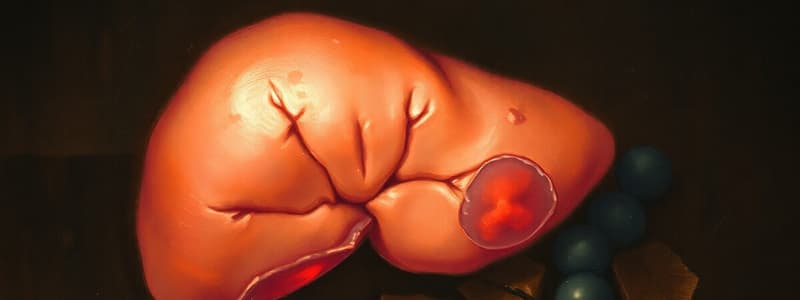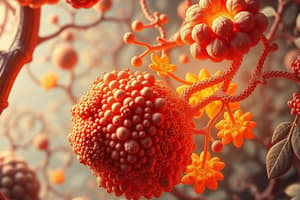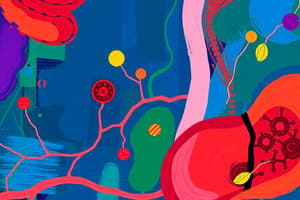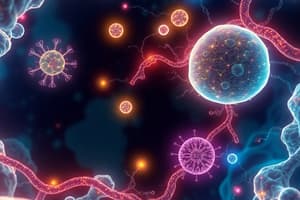Podcast
Questions and Answers
Gluconeogenesis is defined as the synthesis of glucose from carbohydrate precursors.
Gluconeogenesis is defined as the synthesis of glucose from carbohydrate precursors.
False (B)
The liver is capable of replenishing blood sugar through gluconeogenesis due to the presence of glycogen synthase.
The liver is capable of replenishing blood sugar through gluconeogenesis due to the presence of glycogen synthase.
False (B)
Lactate, derived from muscle activity, is a non-carbohydrate precursor that can be converted into pyruvate for gluconeogenesis.
Lactate, derived from muscle activity, is a non-carbohydrate precursor that can be converted into pyruvate for gluconeogenesis.
True (A)
The kidneys are the primary site for gluconeogenesis, accounting for approximately 90% of glucose synthesis.
The kidneys are the primary site for gluconeogenesis, accounting for approximately 90% of glucose synthesis.
Gluconeogenesis is a simple reversal of the glycolysis pathway, utilizing the same enzymes in reverse order.
Gluconeogenesis is a simple reversal of the glycolysis pathway, utilizing the same enzymes in reverse order.
Pyruvate carboxylase (PC) is an important enzyme that catalyzes the conversion of pyruvate to oxaloacetate and occurs in gluconeogenesis.
Pyruvate carboxylase (PC) is an important enzyme that catalyzes the conversion of pyruvate to oxaloacetate and occurs in gluconeogenesis.
PEP carboxykinase (PEPCK) catalyzes the conversion of oxaloacetate to phosphoenolpyruvate using ATP as the energy source.
PEP carboxykinase (PEPCK) catalyzes the conversion of oxaloacetate to phosphoenolpyruvate using ATP as the energy source.
The enzymes involved in gluconeogenesis are under reciprocal control, meaning that if one enzyme is favored, the other catalyzing the reverse reaction is also favored.
The enzymes involved in gluconeogenesis are under reciprocal control, meaning that if one enzyme is favored, the other catalyzing the reverse reaction is also favored.
In gluconeogenesis, the conversion of fructose-1,6-bisphosphate to fructose-6-phosphate is catalyzed by phosphofructokinase-1.
In gluconeogenesis, the conversion of fructose-1,6-bisphosphate to fructose-6-phosphate is catalyzed by phosphofructokinase-1.
Fructose-1,6-bisphosphatase, crucial for gluconeogenesis, is regulated by fructose-2,6-bisphosphate; increased levels of fructose-2,6-bisphosphate inhibit its activity.
Fructose-1,6-bisphosphatase, crucial for gluconeogenesis, is regulated by fructose-2,6-bisphosphate; increased levels of fructose-2,6-bisphosphate inhibit its activity.
The enzyme glucose-6-phosphatase, which converts glucose-6-phosphate to free glucose, is present in muscle tissue, allowing muscles to contribute directly to blood glucose levels during exercise.
The enzyme glucose-6-phosphatase, which converts glucose-6-phosphate to free glucose, is present in muscle tissue, allowing muscles to contribute directly to blood glucose levels during exercise.
The conversion of glucose-6-phosphate to glucose, catalyzed by glucose-6-phosphatase, involves a simple phosphorylation reaction.
The conversion of glucose-6-phosphate to glucose, catalyzed by glucose-6-phosphatase, involves a simple phosphorylation reaction.
Gluconeogenesis requires an investment of 4 ATP molecules to synthesize one molecule of glucose from pyruvate.
Gluconeogenesis requires an investment of 4 ATP molecules to synthesize one molecule of glucose from pyruvate.
Acetyl-CoA inhibits glucose synthesis by deactivating pyruvate kinase.
Acetyl-CoA inhibits glucose synthesis by deactivating pyruvate kinase.
Glycerol can serve as a non-carbohydrate precursor for gluconeogenesis.
Glycerol can serve as a non-carbohydrate precursor for gluconeogenesis.
Biotin is required by the PEPCK enzyme during gluconeogenesis.
Biotin is required by the PEPCK enzyme during gluconeogenesis.
The reaction catalyzed by fructose-1,6-bisphosphatase is reversible.
The reaction catalyzed by fructose-1,6-bisphosphatase is reversible.
The presence of glucose-6-phosphatase in the liver allows it to regulate blood glucose
The presence of glucose-6-phosphatase in the liver allows it to regulate blood glucose
GTP is needed in the reaction to convert pyruvate to oxaloacetate.
GTP is needed in the reaction to convert pyruvate to oxaloacetate.
Amino Acids cannot be used as precursors for new glucose by the process of gluconeogenesis
Amino Acids cannot be used as precursors for new glucose by the process of gluconeogenesis
Enzymes for gluconeogenesis are activated by insulin
Enzymes for gluconeogenesis are activated by insulin
Mitochondria are not key in gluconeogenesis
Mitochondria are not key in gluconeogenesis
One of the three main steps in gluconeogenesis involves the conversion of pyrivate to PEP which only requires 1 enzyme
One of the three main steps in gluconeogenesis involves the conversion of pyrivate to PEP which only requires 1 enzyme
The enzyme glucose-6-phosphatase turns glucose-6-phosphate to glucose within the mitochondrial matrix
The enzyme glucose-6-phosphatase turns glucose-6-phosphate to glucose within the mitochondrial matrix
An important step of regulating gluconeogenesis is when fructose-1,6-bisphosphate converts to fructose -6 phosphate through group transfer reactions.
An important step of regulating gluconeogenesis is when fructose-1,6-bisphosphate converts to fructose -6 phosphate through group transfer reactions.
Flashcards
Gluconeogenesis
Gluconeogenesis
Synthesis of glucose from non-carbohydrate precursors.
Liver's Role in Homeostasis
Liver's Role in Homeostasis
The liver's crucial role in blood sugar regulation.
Non-Carbohydrate Precursors
Non-Carbohydrate Precursors
Lactate, glucogenic amino acids, glycerol and propionyl CoA.
Glucose Homeostasis
Glucose Homeostasis
Signup and view all the flashcards
Main Sites of Gluconeogenesis
Main Sites of Gluconeogenesis
Signup and view all the flashcards
Key Enzymes of Gluconeogenesis
Key Enzymes of Gluconeogenesis
Signup and view all the flashcards
Gluconeogenesis vs. Glycolysis
Gluconeogenesis vs. Glycolysis
Signup and view all the flashcards
Fructose-1,6-bisphosphatase
Fructose-1,6-bisphosphatase
Signup and view all the flashcards
Glucose-6-Phosphatase
Glucose-6-Phosphatase
Signup and view all the flashcards
Energy Cost of Gluconeogenesis
Energy Cost of Gluconeogenesis
Signup and view all the flashcards
Pyruvate Carboxylase
Pyruvate Carboxylase
Signup and view all the flashcards
PEP Carboxykinase
PEP Carboxykinase
Signup and view all the flashcards
Fate of Pyruvate
Fate of Pyruvate
Signup and view all the flashcards
Biotin in Gluconeogenesis
Biotin in Gluconeogenesis
Signup and view all the flashcards
Study Notes
- Gluconeogenesis is the synthesis of glucose from non-carbohydrate precursors.
- It maintains blood glucose levels, particularly during starvation or in diabetes mellitus (DM).
Liver's Role
- Plays an important role in blood sugar homeostasis.
- Replenishes blood sugar because glucose-6-phosphatase is present.
Sources of Non-Carbohydrate Precursors
- Precursors such as alanine are major.
- Lactate comes from muscle and forms pyruvate.
- Glucogenic amino acids.
- Glycerol.
- Propionyl CoA.
Site of Synthesis
- Primarily occurs in the liver (90%).
- Secondarily in the kidneys (10%).
- Pathways occur partly in mitochondria and cytoplasm.
- Gluconeogenesis is not a simple reversal of glycolysis.
- It is under reciprocal control, so physiological conditions favoring one, disfavor the other.
- 2 Pyruvate + 2 NADH + 4 ATP + 2 GTP + 6 H2O results in Glucose + 2 NAD+ + 4 ADP + 2 GDP + 6 Pi + 2H+.
Key Enzymes
- Four key enzymes are involved in gluconeogenesis.
- Pyruvate Carboxylase (PC).
- PEP Carboxykinase (PEPCK).
- Fructose 1,6 Bisphosphatase.
Gluconeogenesis vs Glycolysis
- Gluconeogenesis utilizes four unique enzymes.
- These enzymes bypass three irreversible steps of glycolysis.
- The remaining seven steps use the same enzymes as glycolysis.
Bypassed Reactions and Enzymes
- Hexokinase in glycolysis is bypassed by Glucose-6-Phosphatase in gluconeogenesis.
- PFK (phosphofructokinase) in glycolysis is bypassed by Fructose-1,6-Bisphosphatase.
- Pyruvate Kinase in glycolysis is bypassed by Pyruvate Carboxylase and PEP Carboxykinase.
Obstacle One: Pyruvate to Phosphoenolpyruvate
- In glycolysis, PEP turns into pyruvate via the enzyme pyruvate kinase.
- The reverse reaction in gluconeogenesis requires two enzymes to bypass this step.
- The enzymes in gluconeogenesis are Pyruvate Carboxylase and PEP Carboxykinase.
Conversion of Pyruvate to PEP (Part One)
- The enzyme is Pyruvate Carboxylase.
- Carboxylation reactions use CO2 and the vitamin biotin as a cofactor.
- Pyruvate carboxylase is found only in the liver and kidneys, not in muscles.
- Its location is in the mitochondria, requiring 2 ATP.
Reversal of PEP to Pyruvate
- Oxaloacetate is converted to phosphoenolpyruvate by PEP Carboxykinase, consuming GTP and releasing CO2.
- Simultaneously, in the reverse direction, pyruvate is converted to oxaloacetate by pyruvate carboxylase.
GTP-Dependent Decarboxylation
- GTP-dependent decarboxylation of oxaloacetate involves PEP carboxykinase, a cytosolic enzyme.
- The reaction is: oxaloacetate + GTP to phosphoenolpyruvate + CO2 + GDP.
- GTP is used instead of ATP.
- CO2, is added last in this step.
Alternative Fates for Pyruvate
- Pyruvate can be a source of new glucose.
- It can store energy as glycogen.
- It can generate NADPH via the pentose phosphate pathway.
- Pyruvate can be a source of acetyl-CoA.
- It can store energy as body fat.
- It can make ATP via the citric acid cycle.
- Acetyl-CoA stimulates glucose synthesis by activating pyruvate carboxylase.
Obstacle Two: Fructose-1,6-bisphosphate to Fructose-6-phosphate
- The enzyme is Fructose-1,6-bisphosphatase.
- Bypasses phosphofructokinase-I.
- It is a simple hydrolysis.
- It is highly exergonic and irreversible.
Fructose-1,6-bisphosphatase
- Catalyzes the conversion of fructose-1,6-bisphosphate to fructose-6-phosphate.
- The enzyme is found in the liver.
Obstacle Three: Glucose-6-phosphate to Glucose
- The enzyme involved is glucose-6-phosphatase.
- It bypasses hexokinase.
- Highly exergonic and irreversible.
- Absent in muscle.
- G-6-Phosphatase converts G-6p to Glucose in the liver, kidney, and small intestine.
Energy Requirements in Gluconeogenesis
- Requires 6 ATP to generate one glucose molecule.
- 2 Pyruvate to 2 Oxaloacetate consumes 2 ATP.
- 2 Oxaloacetate to PEP, 2GTP=
- (2)3Phospho glycerate to (2)1,2 BPG =2ATP
Studying That Suits You
Use AI to generate personalized quizzes and flashcards to suit your learning preferences.




